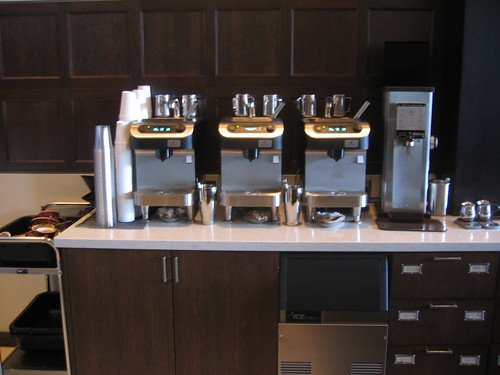Problem is, I was never on the bandwagon with the hipsters who fell hard for the Clover brewer. I know it's unfairly hip now to be anti clover and tote the 'back to manual' bit even when few are willing to spend the time to learn what that really means. Sadly, that's how the online community works. So many people are trying to reinvent the wheel with approaches to pour over and syphon when you really just need to start with a good base. If it was easy, everyone could do it amazingly well and yet we have a generation of barista who came into coffee focused on espresso and latte art that are just in the last year finding these old brewing methods again. The book is still open on that one.
Clover always had a few problems with it's design that kept me from getting behind it. So let's go.
Top 5 reasons you shouldn't feel bad you didn't get a Clover:
#1 Fines. The metal filtration really just didn't do it. Clean cup? Out of the question. You could go with a finer screen but the simple fact was that you cannot equate the depth filtration of a cloth filter or the cleanliness of a paper filter in any metal filtration. If you want a very expensive french press brewer where you end up using a coarse grind and enjoy the sediment, you missed out when Clover was available.
#2 Temperature. On several machines we tested, the actual temperature seemed to have different drifts. It could have been issues with different versions but we noticed very quickly there was a temperature drop in the brewing chamber on the machines we had access to. This one never really made sense when you had a heat wrap that was essentially limited in how high it could be set which would have cured the temperature drop problem. It's hard to argue that anything other than flat line brew temperatures in espresso or any other method is a good thing yet nobody voiced this concern in public.
#3 Extraction. Because of the declining temperature and the fines issue, you simply had an under extraction problem. Shooting for short brew times and volume duty in this design meant sacrificing a full extraction. You could compensate by upping the dose but often the cups were either paper thin with a light dose or all high end and fleeting with a hefty dose. Some rationalized this as a 'Clover Cup' vs a paper filter but it was a widely known issue.
#4 Agitation. The trick to squeezing a little more sweetness always seemed to be contentious. Our version which was not widely practiced is as follows: Make sure the water is up to temp and the chamber is full. Then add the coffee and stir it to get a full immersion. Another optional stir mid brew and then a final stir just as it draws down. Just like a Syphon which allowed our brew times on Clover to be longer than others who used the stock whisk and recommended method. While that could do something towards getting a little fuller sweetness, the other problems of filtration were often made worse by agitation that caused fines to filter to the bottom or center. Anyone who has spent time time with technical Syphon methodology (not the steaming scalding ones of tradition) and pour over begins to see this relationship is very important relative to draw downs and the extraction of bitter and astringent flavors.
#5 Clovernet. Did any of the indy shops who bought a Clover ever have a need for this?
Of course, I now wear my Clover shirt proudly and bring the mug out for special visitors. I like it particularly because the hipsters want to ditch the Clover so badly and knock on it's sale to Starbucks yet when they bought it, it was the best thing ever. Clover is not any better or worse than it was before it was bought but the truth is that like many things in our community, the signal to noise ratio is often pretty poor.
Frankly for the perfect fit, you would need a fairly dark roasted coffee for which you could under extract the roast bitters and then the heavy up dose might squeeze some origin character out of otherwise very stale coffee. Then you just need a customer base that would interpret sediment as body. The coup de grâce would be hundreds or possibly thousands of shops that would need to be coordinated by a simple electronic or possibly online interface that superseded dependence on it's end user for calibration(aka Clovernet).
Tuesday, August 26, 2008
Clover coffee brewer
Let me preface this and say Zander and Co. are good people. Visiting them and seeing the production facility was great fun back in the day and the swag was exceptionally nice. I am happy they made out well.

